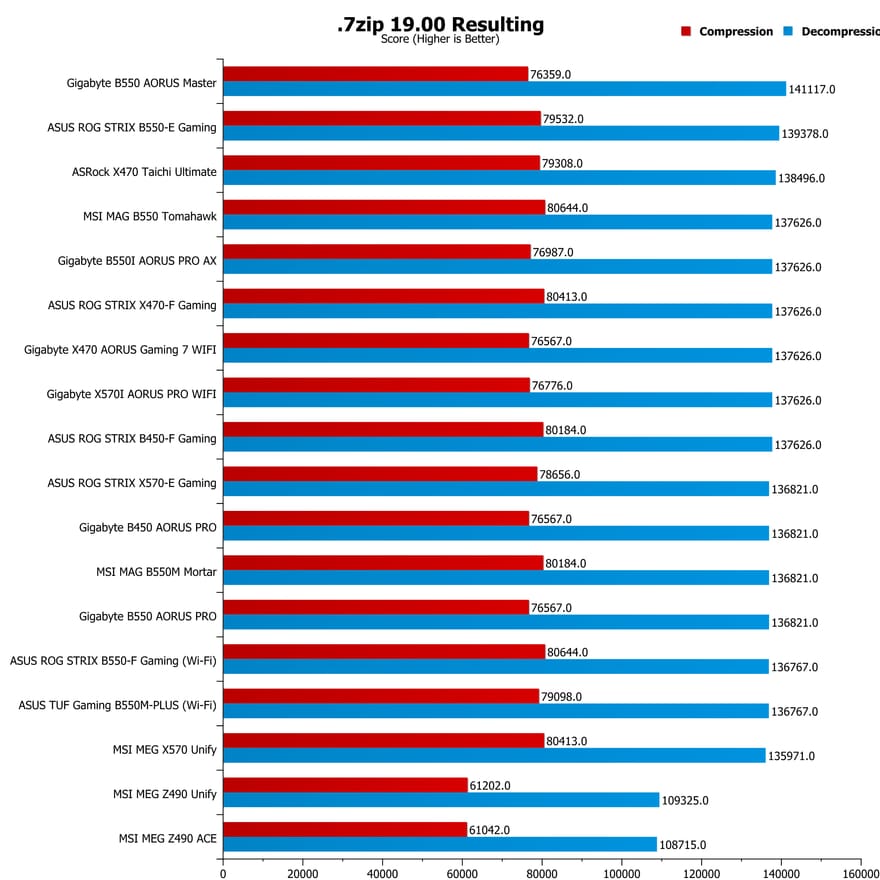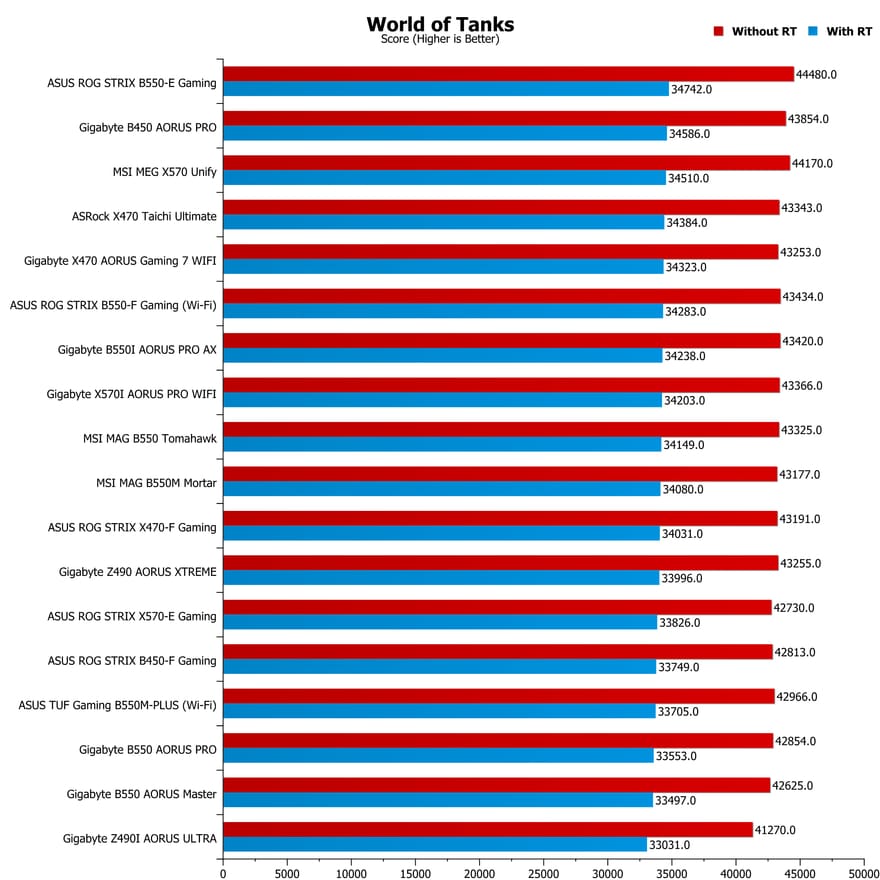MSI MAG B550 Tomahawk Motherboard Review
Peter Donnell / 5 years ago
While the MSI Tomahawk range is one of the more affordable boards in the MSI line up, it’s is still designed with gamers in mind. That means they’ve put the effort into cramming in as much as a gamer could want or need, but still keep an eye on the cost too. They’re not always the most attractive boards either in my opinion, but that doesn’t mean to say they can’t be impressive overall. B550 is the mid-range option for AMD users right now, with X570 still offering the full-fat experience.
MSI MAG B550 Tomahawk Motherboard Review
B550 may be the mid-range, but you still get a sample platter of all the premium features too. You still get some PCIe Gen 4 on one of the PCIe lanes and on one M.2 slot. The board still has a good power delivery setup for hitting those boost clocks and even overclocking. You get super-fast networking, RGB lighting, and great audio. Affordable it may be, but the Tomahawk still has plenty to offer.

Features
- Support for 3rd Gen AMD Ryzen™ Processors and future AMD Ryzen™ processors with BIOS update
- Supports DDR4 Memory, up to 4866+(OC) MHz
- Lightning Fast Game experience: PCIe 4.0, Lightning Gen 4 x4 M.2 with M.2 Shield Frozr, AMD Turbo USB 3.2 Gen 2
- Premium Thermal Solution: Extended Heatsink Design with additional choke thermal pad rated for 7W/mk and PCB with 2oz thickened copper are built for high-performance system and non-stop gaming experience.
- Enhanced Power Design: 10+2+1 Duet Rail Power System, Digital PWM, Core Boost, DDR4 Boost.
- Latest Network Solution: Onboard 2.5G LAN plus Gigabit LAN with LAN Manager deliver the best online experience without lag.
- Mystic Light: 16.8 million colours / 29 effects controlled in one click. Mystic Light Extension supports RGB and RAINBOW LED strip.
- Pre-installed I/O Shielding: Better EMI protection and more convenience for installation.
- Audio Boost: Reward your ears with studio grade sound quality for the most immersive gaming experience.
- Multi-GPU: With Steel Armor PCI-E slots. Supports 2-Way AMD Crossfire™
For in-depth specifications, please visit the official MSI MAG B550 Tomahawk Motherboard product page here.

What MSI Had to Say
“MAG B550 TOMAHAWK features high-bandwidth and low-latency 2.5G plus Gigabit LAN for power users. Onboard 2.5Gbps connectivity provides incredible data transfer speed faster than ever before. MSI LAN Manager automatically classifies and prioritizes the latency-sensitive for your applications, giving you the best online experience with low latency.” – MSI
B550M Motherboard Reviews
- Gigabyte B550 AORUS Pro Motherboard Review
- Gigabyte B550 AORUS Master Motherboard Review
- Gigabyte B550I AORUS PRO AX Motherboard Review
- ASUS ROG STRIX B550-F Gaming Motherboard Review
- ASUS ROG STRIX B550-E Gaming Motherboard Review
- ASUS TUF Gaming B550M-PLUS (Wi-Fi) Motherboard Review
- MSI MAG B550 Tomahawk Motherboard Review
- MSI MAG B550M Mortar Motherboard Review
A Closer Look
The MSI MAG B550 Tomahawk Motherboard comes with a bold two-tone design, and it’s just a little bit too spaced out and busy for my taste. the heatsinks are a bit small and look somewhat floaty, and the white squares on the decal patch stand out too much. Too many lines and angles going their own way. Of course, style is subjective and it doesn’t suit my taste, but that doesn’t mean I don’t like what the board has to offer.

The board features a 10+2+1 Duet Rail Power System, which feeds 10 to the CPU with 60A stages, but then a 2 phase SOC configuration, and a phase for the load line calibration, PWM IC and OP. There are too good size heatsinks keeping it all in order. It’s not the most complex setup, but more than enough to get those boost clocks up for sure.


Further down the board, you’ll find a pair of M.2 mounts. Both feature a small heatsink and while I do think they look a bit small, they’ll certainly help and also protect the drives overall.

I like that they’ve armoured the top PCIe slot, it’s the one all of us are going to use and modern GPUs are pretty heavy. The top slot is the one that offers PCIe Gen 4 also. They’ve put a little bit of reinforcement on the lower slot though, so that’s nice. Obviously, they’re trying to keep costs down hence only the one slot though.
Audio comes courtesy of their Audio Boost processor using the ALC 1220 chipset, and there are five gold caps down here to help provide headphone amplification.

The rear I/O shield is actually really well equipped, offering up a good range of USB ports and even including a Type-C port. There’s not one but two LAN options, with 2.5G and 1G being served up. You’ll also get HDMI and DisplayPort options, and five audio jacks with SPDIF.

How We Test
Here at eTeknix, we endeavour to disclose vital information regarding the benchmarking process so that readers can quantify the results and attempt to replicate them using their hardware. When it comes to our benchmarks in our reviews, the benchmarks are pretty self-explanatory although there are a few exceptions. Remember that your choice of motherboard, the silicon lottery, and other factors can yield different numbers, and there’s always a margin for error when using any software. Therefore, your experience may vary.
Testing Your Own System
We typically focus on commonly available benchmarks so that you too can run the same benchmarks on your own system. We hope this makes it easy for our readers to gauge the performance improvement available to them when they upgrade their own systems.
Gaming Tests
All games are run at their specified resolutions using the “high” settings or equivalent. We avoid using the Ultra settings as these often offer diminishing returns for performance vs visuals.
Test Benches
Comet Lake S
| Processor | All Intel 10th Generation |
| Motherboard | MSI MEG Z490 GODLIKE |
| Memory | 2 x 8GB TEAMGroup NightHawk RGB DDR4-3000 |
| Graphics | NVIDIA RTX 2080 SUPER FE |
| Storage | Seagate Firecuda 510 1TB |
| Power Supply | Phanteks Revolt Pro 850W |
| Software | Windows 10 Professional 1909 |
| Drivers | NVDIA GeForce 445.87 WHQL |
Coffee Lake
| Processor | All Intel 8th & 9th Generation |
| Motherboard | ASUS Maximus XI Hero (WiFi) |
| Memory | 2 x 8GB TEAMGroup NightHawk RGB DDR4-3000 |
| Graphics | NVIDIA RTX 2080 SUPER FE |
| Storage | Seagate Firecuda 510 1TB |
| Power Supply | Phanteks Revolt Pro 850W |
| Software | Windows 10 Professional 1909 |
| Drivers | NVDIA GeForce 445.87 WHQL |
Kaby Lake
| Processor | All Intel 7th Generation |
| Motherboard | Gigabyte Z270X-Gaming 9 |
| Memory | 2 x 8GB TEAMGroup NightHawk RGB DDR4-3000 |
| Graphics | NVIDIA RTX 2080 SUPER FE |
| Storage | Seagate Firecuda 510 1TB |
| Power Supply | Phanteks Revolt Pro 850W |
| Software | Windows 10 Professional 1909 |
| Drivers | NVDIA GeForce 445.87 WHQL |
LGA 2066
| Processor | All Intel 8th, 9th & 10th Generation |
| Motherboard | Gigabyte Z270X-Gaming 9 |
| Memory | 2 x 8GB TEAMGroup NightHawk RGB DDR4-3000 |
| Graphics | NVIDIA RTX 2080 SUPER FE |
| Storage | Seagate Firecuda 510 1TB |
| Power Supply | Phanteks Revolt Pro 850W |
| Software | Windows 10 Professional 1909 |
| Drivers | NVDIA GeForce 445.87 WHQL |
Zen 2
| Processor | All AMD Ryzen 3000 Series |
| Motherboard | ASUS Crosshair VIII Hero |
| Memory | 2 x 8GB TEAMGroup NightHawk RGB DDR4-3000 |
| Graphics | NVIDIA RTX 2080 SUPER FE |
| Storage | Seagate Firecuda 510 1TB |
| Power Supply | Phanteks Revolt Pro 850W |
| Software | Windows 10 Professional 1909 |
| Drivers | NVDIA GeForce 445.87 WHQL |
Zen
| Processor | All AMD Ryzen 2000 & 1000 Series |
| Motherboard | ASUS B450-F Gaming |
| Memory | 2 x 8GB TEAMGroup NightHawk RGB DDR4-3000 |
| Graphics | NVIDIA RTX 2080 SUPER FE |
| Storage | Seagate Firecuda 510 1TB |
| Power Supply | Phanteks Revolt Pro 850W |
| Software | Windows 10 Professional 1909 |
| Drivers | NVDIA GeForce 445.87 WHQL |
Synthetic Benchmarks






Online Benchmarks



Compression & Rendering








Memory & Storage




Gaming Performance




Overclocking

All of the motherboards in the B550 range managed 4.3 to 4.4 GHz on all cores with a voltage of 1.25 to 1.4v, which is pretty much what we expected. While we’re certainly some of the high-end boards will go higher, this will depend on high-end cooling, load-line calibration tweaks, and being lucky to have a very well picked CPU. Of course, we like to stick within the limits of what your average consumer can do with just a few simple tweaks, as B550 is not an enthusiast setup. We simply applied a new multiplier and voltage settings to get the 4.3 – 4.4 GHz.

How Much Does it Cost?
Of course, I’m writing this review before the stock is available on Amazon. However, I will update the prices as the stock goes live after we publish the review. For now, though, you can check the up to date stock of the MSI MAG B550 Tomahawk Motherboard on Amazon UK here, and on Amazon US here.
Overview
MSI has created a pretty fantastic motherboard here. They’ve trimmed back some of the fat to keep the cost down, which is absolutely fine, as they’ve put the money where it matters. The Mortar and Tomahawk motherboards from MSI are often some of the most competitive with any launch and that’s certainly still true today.
Build Quality & Design
The build quality is pretty solid overall. They’ve scaled back some of the heatsink sizes on the boards chipset and M.2 mounts, which saves on materials a bit. I do think the boards looks a little messy and disjointed in places, and I’m not a fan of the white decals. However, when it comes to the CPU, they’ve stuck with big VRM heatsinks, and a good quality power delivery system. The top PCIe is armoured, the rear I/O is pre-installed and you get plenty more beyond. Overall, it’s got everything you need really.
Performance
The board uses a more complicated 10+2+1 Duet Rail Power System with 10 of the phases for the CPU, 2 for the SOC power and one more dealing with APU power, digital PWM IC, load-line calibration and overvoltage protection. Overall, it should handle any of the latest AM4 CPUs easily enough. Of course, with PCIe Gen 4 on the top PCIe lane, as well as one of the M.2 mounts, you’re going to get blazing fast performance in other places.
Added Value
While the board does lack WiFi, it does feature two LAN options. Both 1 GbE and the much faster 2.5 GbE, and you can use MSI LAN Manager to prioritise your gaming traffic too. You get good quality on-board audio thanks to their Audio Boost hardware as well as plenty of Mystic Light RGB.
Should I Buy One?
If you want a well equipped ATX motherboard without the big price tags, this is certainly one of the best options. The design is an aquired taste, but there’s no complaints about their choice of hardware.




















